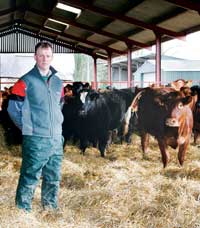Prepare now for spring calving

It may just be a number, but calving at an incorrect condition score could have severe impacts on both cow and calf.
And although spring is just around the corner, it’s not too late to act, says vet Keith Cutler, Endell Vet Group, Wiltshire.
“When cows are too thin it’s vital farmers act straight away by providing supplementary feed, rather than waiting a month before calving to do anything about it. And although it is unlikely poor condition will result in loss of a calf, it could be the cow loses so much muscle mass to provide for the calf that she won’t have strength to calve or even stand up.”
But it’s the knock-on effects of incorrect condition at calving that can be an issue, says Gerry Donelly, Department of Agriculture and Rural Development, Northern Ireland.
“Cow condition at calving influences factors including calf mortality but poor condition at calving will also delay re-breeding, resulting in lengthening of calving intervals and potentially more barren cows.”
He says research indicated cows with a condition score of less than two at calving would be up to three weeks slower getting back in calf. “This means where there are a significant number of cows in a herd less than condition score two at calving, the calving interval will not be maintained at the 365-day target.”
And the ideal condition score at calving should be 2.5, says Mr Cutler. “It’s best to calve in plain at about 2.5 body condition, rather than calving a thin or even too fat animal. By calving in the correct condition, it means calves tend not to be so big and there will also tend to be less fat around the pelvis, which will reduce the number of calving problems.”
Although some advisers may suggest calving up to condition score three, Mr Cutler says calving in slightly poorer condition can have benefits post-calving too.
“Calving in slightly poorer condition maintains appetite and this will help keep energy up post-calving, which will help the cow to start cycling and will also help her to produce sufficient milk. Farmers should make a point of condition-scoring every two to three weeks, particularly in colder weather,” he says
And this is exactly what Scottish beef producer Robert Neill (pictured above) practices with his ideal condition for spring calving cows between 2-2.5.
“For calving you don’t want the cows to be too lean or too fat as they have got to be mated again and both extremes can cause problems at calving. When the cows are in decent condition over Christmas and New Year you will have a lot easier calving.”
But condition score isn’t the only thing important in the run-up to calving, according to Mr Neill, who has almost 300 spring-calving sucklers. It’s important to know the quality of your forage, he says.
“We always have our forage-analysed, so we know when we need to feed any additional supplements. On our land we are low in selenium and vitamin E, both of which are associated with calf vigour, so we supplement these in feed,” he says.
And vitamin and mineral statuses are important, adds Mr Cutler. “Many vitamin and mineral statuses come with the land so it’s important to check for any deficiencies.
“Iodine status is particularly important and the best way to ensure animals have sufficient levels is to provide boluses or free access minerals or by adding potassium iodide to water. When iodine levels are really low this can cause late abortion and ‘dippy’ calves.”
Mr Cutler also emphasises the importance of pregnancy diagnosing. “Although pregnancy diagnosis should have been done by now, it is vital it is done. It is not worth feeding a cow when she is not in calf.”
And there is money to be had from those barren cows, adds Mr Neill. “PD-ing is important prior to calving and with the value of cull cows good at the moment, when you have got an empty cow it is best to feed her up and sell and buy in replacement heifers instead,” he says.
Having calving aids ready is also an important part of preparation, adds Mr Cutler. “Making sure you have a tool box with calving aids. Clean ropes, slip gel and possibly respiratory aids can save time when it is most needed.”
